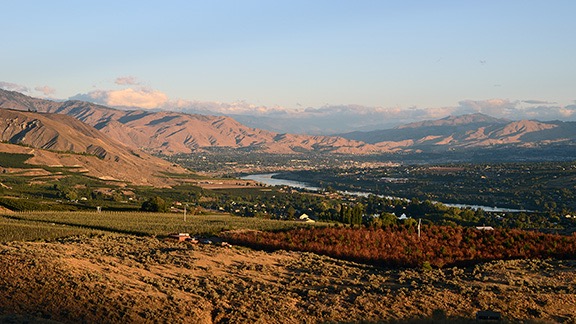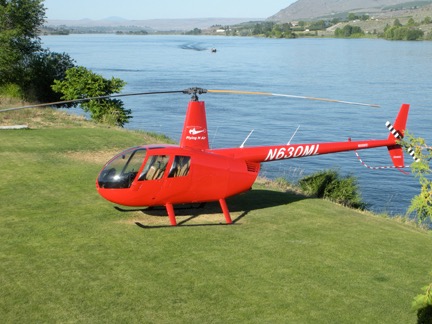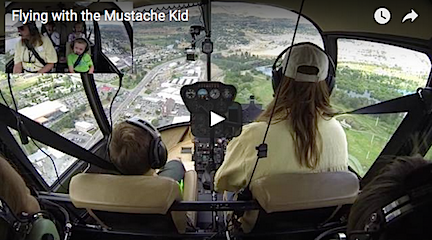The ground crew really makes a difference.
Last Saturday, I made my fifth appearance at Wenatchee Wings & Wheels, an annual event in East Wenatchee. I was offering helicopter rides out of the soccer field on the north side of Eastmont Park for $40 per person.
My History with Wings & Wheels
The first year I did this event was way back in 2012. It’s an October event, long past the end of my cherry drying season in Washington, and back in those days I still lived in Arizona. In previous years, I’d had to pass up participation because I was expected home by August. But in 2012, my divorce was underway and I was finally free to do whatever I liked with my time. So although I went home in mid-September to deal with divorce bullshit and start packing, I left the helicopter behind in Washington. I went back in October with a friend to do the event and then fly the helicopter home.
Wings & Wheels is a car show with an aviation theme. Or at least it was back in 2012. The event was held at the airport and had a great turnout. I was prepared and had asked my friend Jim from Coeur d’Alene to bring his helicopter. He brought along his wife to handle the money and a friend to work with my friend as ground crew.
We flew all day — long past the time when I was hoping to start the flight home. So my friend and I stayed the night and got an early start in the morning. The helicopter was stuffed to the gills with gear, as well as a 40-pound box of Honeycrisp apples one of my clients had given me. We took the most direct route and made it back to Phoenix in 8 hours.
The following year, I was living in Washington. But the powers that be in East Wenatchee had decided to put the event in Eastmont Park near downtown. The best they could offer me was a static display — I flew the helicopter in on Friday evening and left it until Sunday. People could go look at it and I could sell rides for Sunday at the airport. I sold out on all of the rides by noon on Saturday and did them on Sunday. I don’t remember how many I did, but I think it might have only been about 20. A bust, as far as I’m concerned.
In 2014, the airport started hosting its own airport event in June: Aviation Day. That first year, I enlisted the help of two of the cherry drying pilots who work with me. Between the three of us, all flying R44s, we took just over 300 people for rides. That remains my absolute best event in terms of the number of people flown — although I had to split the revenue with my fellow pilots — and that annual event continues to be my busiest every summer.
But in October, the Wings & Wheels folks wanted me to fly, too. They set me up in the soccer field on 3rd and Georgia. I had a reasonable turnout in 2014 and a better one in 2015. But this year was my best so far.
This Year’s Rides at Wings & Wheels
A few things combined to make last Saturday’s event a real winner.
First of all, the weather was perfect. Cool with very little wind meant that my helicopter had good performance and I didn’t have to alter my departure/arrival route. It also meant that a lot of people had come out for the event.
Second, the event was advertised on the radio and in the newspaper. Wenatchee has several radio stations and they’re really good about advertising local events. Although I hadn’t sent out any press releases, the City of East Wenatchee apparently had and had mentioned helicopter rides. So lots of people heard about it on the radio or read about it in the newspaper (or its website) and took advantage of a beautiful day to come on out with their families.
Third, there were a lot of families. A rides event is a great place for a kid to get a first helicopter ride without mom and dad breaking the bank. The rides were $40/person. More than a few people told me or my ground crew that they’d rather spend the money on a memorable helicopter ride than a few amusements at the carnival that had also set up in the park.
Fourth was my ground crew. They were responsible for collecting the money, doing passenger safety briefings, and loading/unloading passengers. I do “hot loading” at all of my events — that means the engine is running and the blades are turning the whole time. The ground crew is responsible for keeping the landing zone secure and keeping passengers and onlooker safe. (The park people helped out by setting up T-posts with caution tape to create a landing zone boundary.) Without a good crew, I cannot make a rides event work. (More on that in a moment.) This year’s crew was excellent.
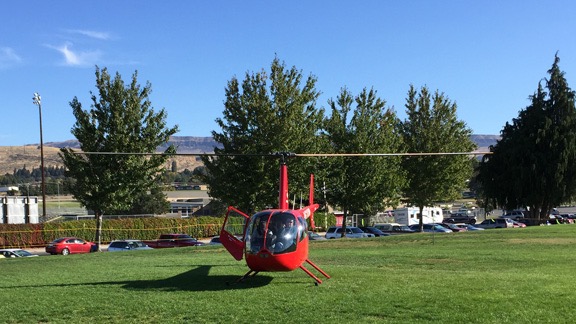
Alyse, from my ground crew, took this photo of me just before departing on my first flight of the day.
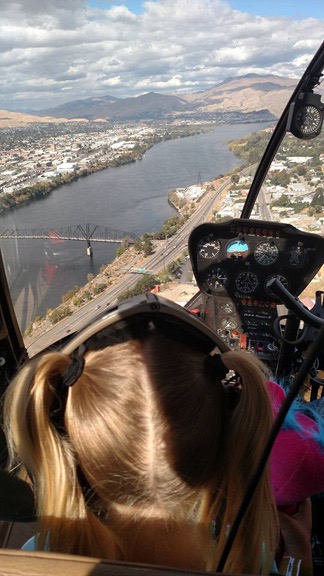
Here’s a photo from one of my back seat passengers that was shared on Flying M Air’s Facebook page. In this shot, we’re going upriver on the East Wenatchee side.
I’ve created a sloppy little map of the setup at the park (see below). The car show — which was huge — was in the baseball fields, on the grass. I didn’t get to see it, other than from the air. North of that were some food vendors and other booths for other things. I didn’t really get to see any of that, either. Then there were some tennis courts and then our landing zone. The red box outlines the area the park people secured for us with posts and tape. East of us was a dirt area with RC trucks racing around and beyond that was a handful of carnival rides.
On departure, I took off to the east, avoiding the trees to the north of my area and trying to avoid the dirt track and carnival. Then I made a circle around the car show area, mostly to make sure everyone on the ground knew there were helicopter rides before heading out to the river. You can see this with the green line. I flew up the East Wenatchee side to the north end bridge and then flew back down the Wenatchee side to the south end bridge. Then I came east and returned to my landing zone by way of a few empty school fields north of the landing zone. You can see this with the blue line.
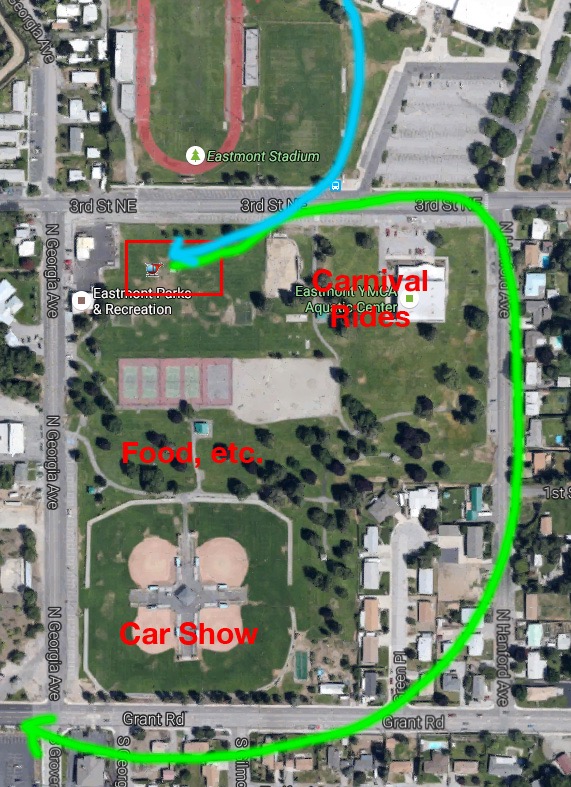
Here’s the general layout of the event.
We made the paper the next day, too.
The Importance of a Good Ground Crew
In the past, I’ve worked with a variety of different people as my ground crew.
When I did events in Arizona, my wasband often helped out. He knew the drill pretty well but could also be counted on to complain incessantly after each event. On large events, I’d get someone else to work with him. I pay my ground crew and often pay based on the number of rides we do. (Although my wasband always refused to take any money, he later told the divorce judge that working for free at a handful of events over the years made him a part owner of my company. Lying in court about the actual number of events — over a hundred? — didn’t work well for him, either.) We often do dinner, too, on my dime. And, of course, I provide chairs and a cooler full of refreshments for the crew while I fly.
The best ground crew are the people who understand that the goals are:
- Safety. This is my number one concern. Accidents are not an option. Not only can they ruin an event and likely prevent me from doing future events in the area, but they’re bad for public relations. People are already afraid of helicopters, mostly because they don’t understand how they fly. To have someone get hurt an event confirms those fears. I’ve never had a mishap and I want to keep it that way.
- Crowd control. When lines form, people bicker. At least I was told that they did in Arizona. In Washington, people are much more laid back and easy going. I’ve never had a local ground crew complain about a crowd, even when wait time exceeded an hour.
- Quick turnarounds. The quicker my ground crew can unload passengers and load up the next group of passengers, the quicker I can take off. My ride times are pretty fixed at 8 to 10 minutes. Shortening them would make passengers think they didn’t get their money’s worth. So to keep things moving, the ground crew has to keep things moving on the ground. I’ve worked with slow ground crews before and it is frustrating — especially for the folks waiting to get off who can’t depart without an escort and the ones watching the helicopter idle while they wait for their turn.
- Maximize passenger count. This is where I either make money or lose it. At the $40/person pricing, I lose money on every flight with just one person on board, so I simply won’t do flights for singles. (You can’t make money on quantity if you lose money on individual flights.) With two people on board, I make money. With three people on board, I make good money. The best ground crews are the ones that consistently put three people on board each flight. This not only helps make the event profitable, but it reduces the wait time for passengers. Got a couple up next? Find a single farther back in the line and put him on board, too.
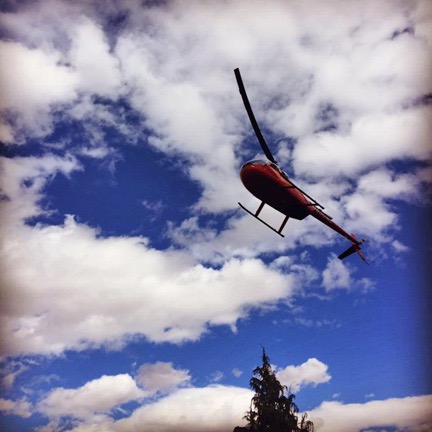
An onlooker who didn’t fly with us posted this photo on Facebook of us flying by.
I had my friend Alyse and her friend Diana work with me at this event. This was their first time working with me. Both women are pretty sharp and caught on right away. Although they weren’t as quick as I’d like at turnarounds — at least in the beginning — they somehow managed to get three people on almost every single flight. I’ve never had that done before at an event — I consider myself lucky if half the flights have two people and the other half have three. (The last Aviation Day event had just two people on most flights.) So not only did I fly a lot more people than I had in previous years, but I also earned more money per hour flown. In fact, on a per-hour basis, it was my most profitable event ever.
My Thoughts on Rides Gigs
I have a lot of thoughts about rides gigs. Although I only do 2 to 4 of them per year, I’ve been at it for 15 years. Without consulting my logbooks, I figure I’ve done about 50 of them by now. I did three this year: Aviation Day (at the airport), Farmer-Consumer Awareness Day (at a field in Quincy), and Wenatchee Wings & Wheels.
Every event is just different enough to keep it interesting. But I have to admit that flying the same route over and over — and answering the same handful of questions — all day long is not my idea of fun. If I didn’t make money at these events, I wouldn’t do them.
One thing I really do like about them is the fact that for at least half of my passengers, their flight with me is their first time in a helicopter. Occasionally, it’ll be their first flight in any aircraft. I like the fact that I can give them an affordable first experience and that I can often take away any fears about helicopter flight that they might have. It’s not crazy, like a roller coaster. It’s smooth, with an amazing view of someplace they see every day from the ground. I especially like it when the kids point out places they recognize but have never seen from the air. It makes the experience fresh for me, too.
As for the regulars, well, it’s nice to be able to see that there are some folks who return every year for another flight, even though it’s the same flight as the previous year. I must be doing something right if they keep coming back.



